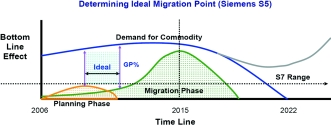
ITmatic has performed significant research to determine the best time to migrate from one range to another within the automation domain. The reason for this research is that the different suppliers all have different strategies to introduce new ranges which often results in confusion within the existing client base. The first strategy followed by some suppliers is to publicise the fact that their old range is to become extinct while the second strategy followed by other suppliers is to encourage the use of their newer range by offering incentives in the hope that their older range slowly dwindle away by itself.
ITmatic believes that it is best to use the analogy of phasing out a private motor vehicle as an example when making this decision. Granted not all people view motor vehicles as a tool of the trade and often change them when they need new tyres or the maintenance plan is almost finished. Others have found age seven (7) to be the best age - as the vehicle is paid off, a deposit has been saved for and signs of failures are becoming evident.
The best time to upgrade
The three most critical variables that determine the ideal time to migrate is: first of all, the demand forecast for the client's sector, second, the point at which technology is phased out and third, clients' progress in terms of planning the migration. Using the example of an industry that has a positive forecast until 2022 and the example of a specific Siemens Simatic S5 range of equipment scheduled to be redundant by 2015 then the ideal point to migrate should be from 2009 to 2012.

Why not later
The first reason is that the above recommended timing will have the least impact on the bottom line since it can be afforded from a financial perspective (not from a down time perspective). The second reason is that based on increased product life cycles of PLC equipment the migration should be synchronised with future releases along with anticipated upswings in demand. Finally a third reason is that true decentralised configurations should then be the norm based on advances in intelligence of field equipment allowing for complete concept changes to be followed.
Understanding risk
While it is important to consider the best point to migrate, it is also important first of all to understand why migration is important and secondly what alternative options exist. The main motivation for migration is normally always risk followed by inability to expand the existing system. In terms of risk a few key concepts exist namely:
* The system is only as strong as the weakest link in the chain while each client has a different tolerance to risk.
* Different components have different risk profiles, life cycles and are impacted differently by external factors ie, environment.
* The Risk/Reward Ratio indicates more value is added on higher order systems than just the PLC.
ITmatic says that it is most vital to understand the risks exposed in order to be able to start to plan for the long term. It is also important to take cognisance of the short term solutions or 'quick fixes' offered by other players that offer methods to extend the life of equipment as the major problems still remain a support issue.
While support should receive attention, focus should also be placed on methods to add value such as management information systems (MIS) or even reporting depending on the flexibility of the system. If it is decided to upgrade it is vital to review the design for areas of improvement in order to leverage advances of technology. Remember funds spent can not be easily justified if no value is clear ie, production increases, etc, - especially if the life cycle of equipment can be up to 100 years for some of the PLC equipment. If a client wishes to increase profitability, in all cases, alternatives exist such as changing the philosophy of operation, etc.
About ITmatic Consulting Services
It is the vision of ITmatic Consulting Services, to 'manage the pre-implementation process and beyond' for its strategic clients. Its objective is 'to be industry thought leaders' that strive to commoditise all aspects of the market it is active in through the provision of its consulting services.
For more information contact Petrus Klopper, ITmatic Consulting Services, 082 559 7437, [email protected], www.itmatic.co.za

© Technews Publishing (Pty) Ltd | All Rights Reserved